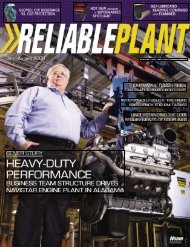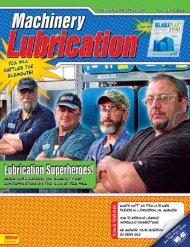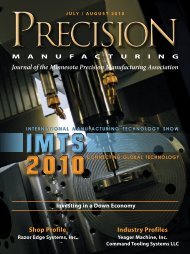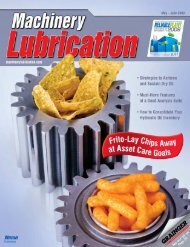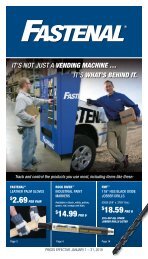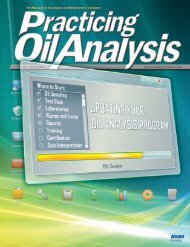Machinery Lubrication July August 2008
Machinery Lubrication July August 2008
Machinery Lubrication July August 2008
Create successful ePaper yourself
Turn your PDF publications into a flip-book with our unique Google optimized e-Paper software.
CONTAMINATION CONTROL<br />
filter cartridges and increased maintenance<br />
costs.<br />
Expenses of Varnish<br />
Having to change or clean hydraulic<br />
system servo valves and risk system failure<br />
are some of the results of varnish. A new<br />
servo valve can cost $3,000, and approximately<br />
$2,000 to clean and refurbish. But<br />
the expense doesn’t end there. Don’t forget<br />
the associated labor and shutdown costs,<br />
both of which impact your bottom line.<br />
And if the system fails, your income<br />
declines as well.<br />
Let’s put that into real-world terms in the<br />
following example: A large plastic injection<br />
molding company produces between 20<br />
million and 30 million parts per month with<br />
more than 200 machines that range from 33<br />
to 770 tons. The hydraulic fluid reservoirs in<br />
these machines range from 80 to 250<br />
gallons. The equipment operates 24 hours a<br />
day, five days a week. Excluding lost production,<br />
the estimate of the yearly cost due to<br />
varnish is approximately $135,000.<br />
In addition to potentially triggering<br />
premature replacement of control valves, if<br />
left uncorrected, varnish can reduce filter<br />
load-carrying capacity and plug supplemental<br />
cooling system orifices.<br />
Solution to Varnish<br />
In the past, equipment users replaced<br />
servo valves or cleaned them as needed to<br />
keep their systems operating. Electrostatic<br />
filters and precipitators have been used<br />
successfully but have some shortfalls,<br />
including their cost and the loss of productive<br />
floor space in the plant.<br />
The ideal solution is to use hydraulic<br />
fluid that does not allow varnish to deposit<br />
on metal surfaces while it provides important<br />
wear and corrosion prevention and<br />
water separation capabilities. Because<br />
hydraulic formulations are carefully<br />
balanced to meet OEM requirements,<br />
adding a new varnish-mitigating feature to<br />
the fluid’s performance profile requires a<br />
unique solution.<br />
Fluids are now available that incorporate<br />
additive chemistry that reacts with the<br />
precursors to varnish, minimizing the formation<br />
of resinous films on system hardware.<br />
This technology recently achieved Denison<br />
HF-0-approval.<br />
Laboratory testing demonstrates the<br />
clean feature offered by these new fluids. In<br />
industry-accepted pump tests, many widely<br />
used fluids show varnish formation within<br />
500 hours of beginning operation. Compare<br />
that to the results found in the new additive<br />
technology solution to the age-old varnish<br />
problem: Even after 1,000 hours of use,<br />
there is no evidence of varnish formation.<br />
Industrial hydraulic systems typically<br />
operate at approximately 140°F, although<br />
temperature spikes up to 180°F are<br />
common. High-temperature applications<br />
that place thermal stresses on the oil - such<br />
as plastic injection molding machines, glass<br />
transfer systems, heavy presses and mobile<br />
equipment - are ideal candidates for this<br />
new technology. It also is a good choice if<br />
you want to improve the productivity of<br />
your equipment and extend the life of oil,<br />
equipment and components such as valves,<br />
filters and pumps.<br />
Today’s hydraulic fluids are subjected to<br />
increasingly tough operating conditions.<br />
Demands to increase production at the<br />
same time that oil volume is decreasing<br />
emphasize the importance of using highquality<br />
hydraulic fluids. Increased<br />
operating temperatures have resulted in<br />
today’s hydraulic systems developing<br />
varnish deposits over time that can lead to<br />
problems. The availability of new additive<br />
chemistries goes hand-in-hand with today’s<br />
harsher operating conditions.<br />
About the Author<br />
Rob Profilet is the commercial manager for industrial<br />
hydraulic and gear oils with the The Lubrizol<br />
Corporation. For more information, visit<br />
www.lubrizol.com.<br />
20 <strong>July</strong> - <strong>August</strong> <strong>2008</strong> machinerylubrication.com <strong>Machinery</strong> <strong>Lubrication</strong>






